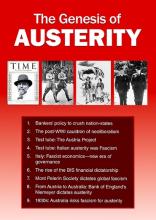Australians are suffering mortgage and rental stress in record numbers, for the sake of “fighting inflation”—a bogus target, which prioritises private bankers’ balance sheets over people’s well-being. What you need to know, to get free of this brutal policy, is in “The genesis of austerity”, a nine-part series by Australian Alert Service editor Elisa Barwick. Published in the Australian Almanac over the course of 2023, this ugly story of how “austerity” became economic and political dogma is now available as a pamphlet!

Barwick documents how the City of London banking elite, working through the UK Treasury and the Bank of England (BoE), worked up programs of fiscal, monetary and industrial austerity—belt-tightening by governments and people—in the 1920s, and imposed them on war-torn Europe. These policies were not effective (and never are) in actually reducing inflation, but they fuelled the rise of fascism. Highlights of the series are the desperation of the City of London and its allies to sabotage a revival of national banking for physical economic development, which had spread worldwide after Abraham Lincoln’s victory in the American Civil War; the BoE-led creation of “neo” liberal rules of inflation-fighting, budget-balancing, debt service prioritisation, and suppressing national credit-creation, at international financial conferences in the 1920s; the introduction of supposedly non-political expert economists to insist that there is no alternative to austerity; the horrific results of austerity pilot projects in Austria and Italy; the formation of the Bank for International Settlements, the world centre of the bankers’ dictatorship to this day; and the Mont Pelerin Society’s drive to enshrine the new economic “rules of the game” worldwide after World War II.
As a mainstay of economic rationalism, austerity is propagandised as being necessary to repair state finances and provide for the future, but its imposition is so intimately aligned with dictatorial enforcement methods, up to and including fascism and Nazism, that austerity should be called “economic fascism”.
The final two articles are on Australia’s “Old Labor” firebrands, who fought against squeezing the population to sustain a bloated financial aristocracy—the “Money Power”, whom they denounced as "bloodsuckers”. Australia’s strong tradition of national banking is the basis for defeating the regime of permanent austerity today.
Download by section:
- Part 1: Austerity: bankers’ policy to crush nation states
- Part 2: The post-WWI cauldron of neoliberalism
- Part 3: Test tube: The Austria project
- Part 4: Test tube: Italian austerity was Fascism
- Part 5: Italy: Fascist economics opens new era of governance
- Part 6: The rise of the BIS financial dictatorship
- Part 7: The Mont Pelerin Society dictates global fascism
- Part 8: From Austria to Australia: Bank of England’s Niemeyer dictates austerity
- Part 9: The 1930s: Australia risks fascism for austerity
Other articles on austerity
A review of the austerity response to the 2008 global financial crisis in a three-part series inspired by Mark Blyth's, Austerity: The History of a Dangerous Idea:
- Collateral damage: how the housing bubble blew up global finance (AAS, 1 Feb. 2023)
- The 2008 crisis and the European sinkhole (AAS, 15 Feb. 2023)
- Our economic model is based on permanent austerity (AAS, 15 Mar. 2023)







